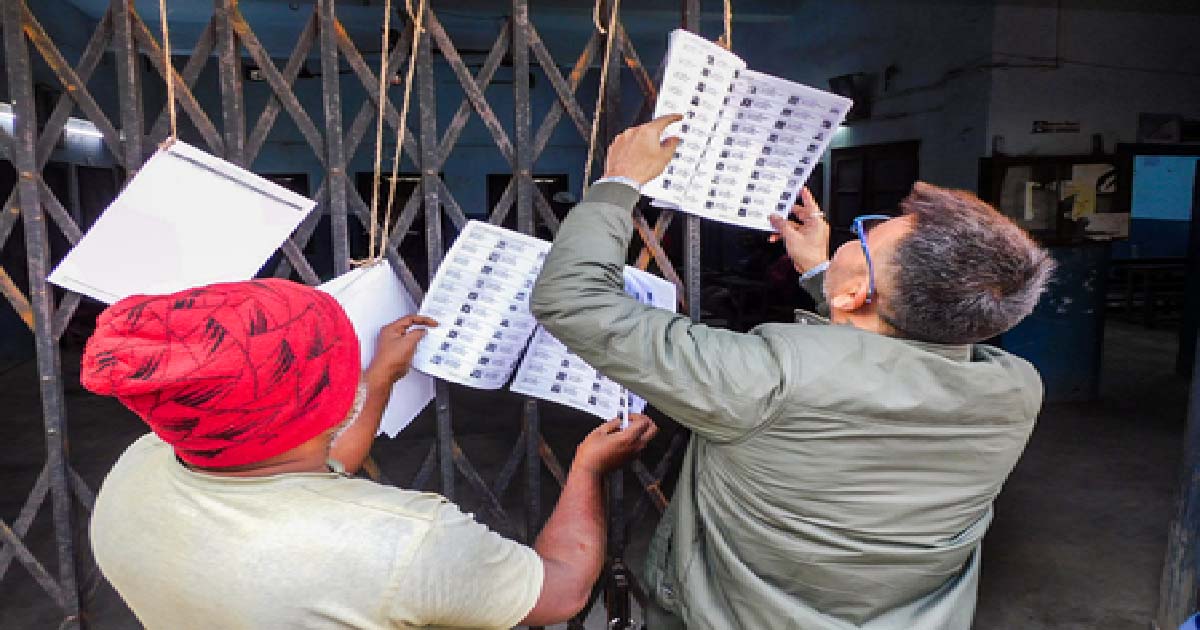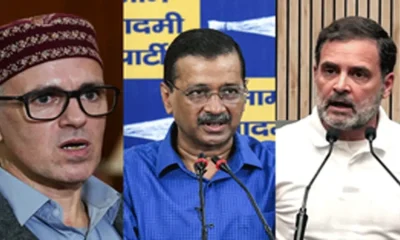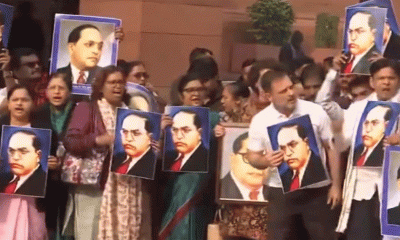National News
SC refers to CJI Cong leader’s petition for verification of EVMs used in Haryana polls

New Delhi, Dec 13: A2-judge Bench of the Supreme Court on Friday directed the apex court registry to place before the Chief Justice of India (CJI) for passing an appropriate order to list a plea filed by Congress leader seeking verification of Electronic Voting Machines (EVMs) used during Haryana Assembly polls.
A bench of Justices Vikram Nath and P.B. Varale opined that the matter should be placed before the same Bench which had passed directions on EVMs in April this year.
It said that the present petition seeking directions to the Election Commission of India (ECI) to lay down a memorandum for the checking and verification of the original burnt memory/microcontroller of the four components of the EVM relates to interpretation and implementation of the previous judgment of the apex court and therefore, the registry should place the papers before CJI, who is the master of the roster, for passing appropriate orders as to whether the petition should be listed before the previous Bench.
In order to strengthen the integrity of the election process in the country, a bench of Justices Sanjiv Khanna (now CJI) and Dipankar Datta, in April this year, had passed a direction for checking and verification of the burnt memory/microcontroller in 5 per cent of EVMs for any tampering or modification on a written request made by candidates securing second and third highest votes in an election.
The court said the checking and verification exercise was directed to be undertaken by a team of engineers from the manufacturers of the EVMs, with the candidates and their representatives having the option to remain present at the time of such exercise.
The fresh petition filed by Karan Singh Dalal, a former 5-time MLA, said that the ECI has not issued any procedure for checking and verification of the original burnt memory/microcontroller of the four components of the EVM (Control Unit, Ballot Unit, VVPAT and Symbol Loading Unit) in terms of SC judgment.
The plea sought directions to the poll body to lay down a memorandum for checking and verification of the original burnt memory/microcontroller of the four components of the EVM (Control Unit, Ballot Unit, VVPAT and Symbol Loading Unit).
It further sought that the above exercise be undertaken within eight weeks and be made applicable to the EVM checking and verification forms dated October 14 submitted to the ECI.
The petition said that the issue raised in the petition requires to be authoritatively decided by the apex court owing to significant public importance and ramifications across the country.
“The matter affects the functioning of the democracy in the country and elections being held across the country in various states, and therefore needs to be urgently and authoritatively decided,” it said.
The absence of any procedure for verification of burnt memory for tampering shows reluctance on the part of the ECI to subject the original burnt memory microcontroller from any scrutiny whatsoever, contended the petition.
Business
Gautam Adani hails war heroes, workers, farmers, and specially-abled as NMIA commences operations

Mumbai, Dec 25: Gautam Adani, Chairman of the Adani Group, hailed war heroes, farmers, and the specially abled as the Navi Mumbai International Airport (NMIA) — India’s newest Greenfield airport — welcomed its first passengers on Thursday.
The airport, inaugurated by Prime Minister Narendra Modi on October 8, began its operations on the day of Christmas.
Welcoming the first passengers, the Adani Group Chairman saluted the soldiers who protect the nation, workers who built the airport for their “unbreakable spirit”, farmers who feed the country, and the specially abled who inspire the nation.
“It was a deeply moving moment to stand beside Param Vir Chakra awardees Captain Bana Singh and Subedar Major Sanjay Kumar as the Navi Mumbai International Airport (NMIA) welcomed its very first passengers,” said Gautam Adani, in a post on social media platform X.
“In that moment, alongside the war heroes, stood the other quiet architects of the nation — the workers who built this airport with their bare hands and unbreakable spirit; the farmers and their families who feed India; the social workers who selflessly serve millions alongside the @AdaniFoundation; and our specially abled colleagues who inspire us every single day. For many of them, this was the first flight of their lives,” the Adani Group Chairman added.
“Soldiers who protect Bharat. Workers who build Bharat. Farmers who sustain Bharat. Social workers who serve Bharat. The specially abled who inspire Bharat,” the industrialist said.
Gautam Adani stated that NMIA showcases an opportunity for the country to move forward without leaving anyone behind.
“@AdaniPriti and I were deeply honoured to stand with them at NMIA – a moment that captured what this airport truly represents – opportunity with dignity, and a rising India that moves forward without leaving anyone behind,” the Adani Group Chairman said.
“Their blessings, their courage, and their resilience drive us every single day to build bigger, serve better, and work harder in service of the nation. Jai Hind,” the businessman added.
NMIA is a public-private partnership (PPP) between Mumbai International Airport Limited (MIAL), a subsidiary of Adani Airports Holdings Limited (AAHL), which holds the majority stake of 74 per cent, while the City and Industrial Development Corporation of Maharashtra Limited (CIDCO) hold the remaining 26 per cent.
In the first month, NMIA will operate for 12 hours — between 08:00 hours and 20:00 hours — handling 23 scheduled daily departures.
During the initial launch period, passengers will benefit from services operated by IndiGo, Air India Express, and Akasa Air, connecting Mumbai to 16 major domestic destinations.
Starting February 2026, the airport will transition to round-the-clock operations, expanding to 34 daily departures to meet the increasing needs of the MMR.
NMIA is also conducting comprehensive Operational Readiness and Airport Transfer (ORAT) trials in collaboration with all stakeholders, including security agencies and airline partners.
Crime
Days before SIR hearing process, BLO goes missing in Bengal’s East Burdwan

Kolkata, Dec 25: A Booth Level Officer (BLO) has gone missing in West Bengal’s East Midnapore district before the start of the hearing process of the Special Intensive Revision (SIR) exercise, said the police on Thursday.
According to his family members, he has been untraceable for the past two days. The BLO’s identity card is at his home, along with various enumeration forms and related documents. The disappearance of the BLO before the public hearing of the SIR process has caused a stir in the area.
The district administration has also launched efforts to find the missing BLO.
The police said that the name of the BLO is Amit Kumar Mondal, a resident of Bikihat area under Khajurdihi Panchayat in Katwa I block of East Burdwan district, and a teacher by profession. He teaches at Uddharanpur Primary School in Ketugram. He is in charge of Booth No. 23 of the Katwa Assembly constituency as a BLO.
According to his family, on Tuesday, around 10 a.m., the BLO returned home from the market, parked his motorbike and went out again. He told his family that he had a BLO meeting. After the afternoon passed, the BLO did not return home.
When the family members started a search for him, they found his mobile phone, BLO identity card and SIR-related documents lying at home. The family searched for him in various places, including the homes of relatives, but could not trace him. That same night, the family filed a missing person report at the Katwa police station. It has been over two days, and there is still no trace of him.
The mystery surrounding Amit Kumar Mondal’s disappearance is deepening. The family is also clueless about the reason for his disappearance. The family claimed that he had been under some pressure since taking the responsibility of working as a BLO
It is learnt that there are 641 voters in Amit Kumar Mondal’s Booth No. 23. He had distributed notices to 33 voters for the hearing. The hearing is scheduled to begin in two days, where his presence as the BLO is mandatory.
However, his disappearance before that has put the administration in a challenging position. Katwa Sub-Divisional Officer Anirban Basu did not give any official statement to the media on this matter.
Sources said that if he is not found in due time, then a replacement will be made to complete his unfinished work.
A senior officer of East Burdwan district police said, “Based on the missing person diary lodged by the family, a search has started to trace the BLO. So far, he has not been found.”
National News
Mumbai: Major Fire Erupts At Andheri’s Sorrento Tower; Over 40 Rescued Safely

Mumbai: A major fire erupted in a residential high-rise, Sorrento Tower, located on Veera Desai Road, Andheri West on Thursday morning, in which several people were stranded. The incident of fire was reported to Mumbai Fire Brigade at 10.05 am.
Over 40 residents from the upper floors who were stranded at upper floors were rescued by the firefighters. Due to swift action by the authorities, no injury was reported and all residents were evacuated safely.
“The incident took place in Sorrento Tower, Veera Desai Road, near country club, Andheri West. Total 30-40 people from 16th floor refuge area are safely rescued through staircase. Two males and one female safely rescued from flat no 1503 on 15th floor using BA set.”
“The fire was confined to electric wiring, electric installation etc in electric shaft from 10th floor to 21st floor and router, shoe rack, wooden furniture etc near electric duct on various floors of Stilt+ 4 Podium+ 5th to 22nd floors residential building,” the report from BMC disaster management said.
Agencies including Mumbai Fire Brigade, Police, staff from concerned Electricity Distribution Company, ambulance and Ward staff are deployed on the spot.The fire was declared Level 1 on 10.20 am and doused at 11.37 pm. No injuries were reported.Further details are awaited in the incident. The authorities are investigating the cause of fire.
-

 Crime3 years ago
Crime3 years agoClass 10 student jumps to death in Jaipur
-

 Maharashtra1 year ago
Maharashtra1 year agoMumbai Local Train Update: Central Railway’s New Timetable Comes Into Effect; Check Full List Of Revised Timings & Stations
-

 Maharashtra1 year ago
Maharashtra1 year agoMumbai To Go Toll-Free Tonight! Maharashtra Govt Announces Complete Toll Waiver For Light Motor Vehicles At All 5 Entry Points Of City
-

 Maharashtra1 year ago
Maharashtra1 year agoFalse photo of Imtiaz Jaleel’s rally, exposing the fooling conspiracy
-

 National News1 year ago
National News1 year agoMinistry of Railways rolls out Special Drive 4.0 with focus on digitisation, cleanliness, inclusiveness and grievance redressal
-

 Maharashtra1 year ago
Maharashtra1 year agoMaharashtra Elections 2024: Mumbai Metro & BEST Services Extended Till Midnight On Voting Day
-

 National News1 year ago
National News1 year agoJ&K: 4 Jawans Killed, 28 Injured After Bus Carrying BSF Personnel For Poll Duty Falls Into Gorge In Budgam; Terrifying Visuals Surface
-

 Crime1 year ago
Crime1 year agoBaba Siddique Murder: Mumbai Police Unable To Get Lawrence Bishnoi Custody Due To Home Ministry Order, Says Report






















